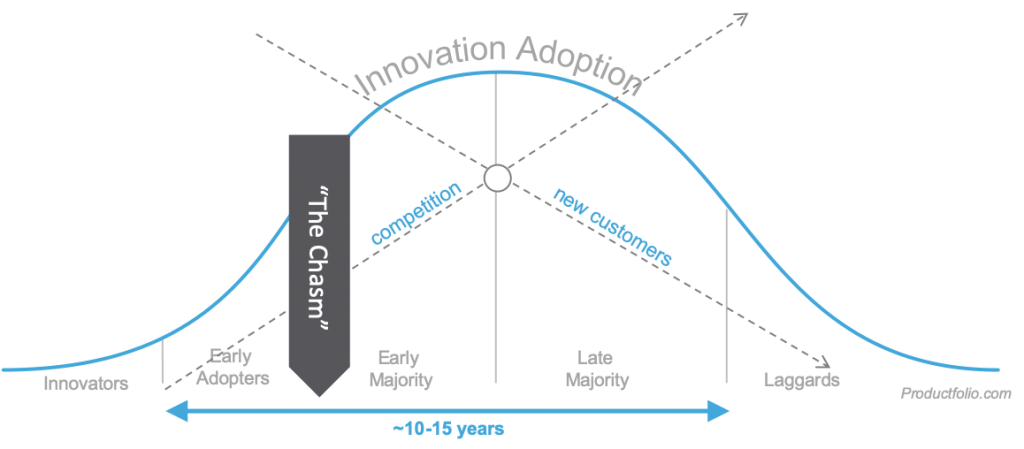What is the Innovation Adoption Curve?

The Diffusion of Innovations theory illustrates how, why, and at what rate new ideas and technologies spread throughout a social group or community. The theory introduces the Innovation Adoption Curve and breaks down each community or social group into five adopter groups, “Innovators”, followed by “Early Adopters”, next is “Early Majority”, then “Late Majority” and lastly the Laggards, and is often represented with a well-known visual model, the Innovation Adoption Curve.
The Diffusion of Innovations theory was developed by Everett Rogers in 1962 and published in the book “Diffusion of Innovations”. Rogers’ theory is that Diffusion is a process by which innovation (a new product) is communicated over time within a community or social group. Beyond its immediate implications about the importance of timing and early market entry, Rogers theory also tells us that if you want your product to have widespread adoption, you need to market to each group differently using distinct marketing efforts targeting each specific group.
Innovation of Diffusion Adopter Groups
Innovators – This is a small, but very important group. Innovators are always the first to learn about and adopt a new product, or trend. Innovators, are risk-takers, adrenaline seekers and enjoy being on the cutting edge. This group likes being associated with spotting trends and being “the first”, they spread the word of your new product throughout their community.
Early Adopters – Early adopters are also a small but important group. This group is highly respected in social groups as being opinion leaders. Early adopters aren’t the first to adopt a product or trend, but pick up on it just after the innovators spread the word.
Early Majority – The Early Majority likes to observe others’ experiences before adopting a new product or trend. This group likes for something to be socially accepted as the new status quo with proven benefits before they adopt. Early Adopters are more risk-averse the Innovators and Early Adopters. This group is socially active in their community and has influence within their social group.
Late Majority – Approximately two-thirds of all adopters reside in either the Early Majority or Late Majority group. The Late Majority is resistant to change and is adverse to risk. This group will only adopt once a product, service or trend has become entrenched in the market and is a common standard.
Laggards – This group is the least likely to adopt your new product. Laggards are highly resistant to change, and will only adopt a new product or service if have to, or if it becomes completely mainstream.
Crossing the Chasm
Geoffrey Moore expanded on the Diffusion of Innovation model in 1991 when his book “Crossing the Chasm” was published. Crossing the Chasm during the Early Adopters phase was incorporated into the Diffusion of Innovation model after Moore’s publication and is now the standard interpretation. In Moore’s book, he argues that there is a chasm between the early adopters of the product and the early majority. Moore states that the visionaries and the pragmatist majority are very different types of people and that there is a threshold (the chasm) that needs to be crossed over to reach the mainstream adoption of a product. This is also the optimal time to enter a market because it is still early enough to prepare before the market majority is reached, but after sufficient market validation has occurred to reduce the risk of entry.
Five Stages of the Adoption Process
The Diffusion of Innovation breaks down the progression of the five stages that an individual goes through while accepting change.
- Knowledge – The individual learns about a new product
- Persuasion – Convincing the individual of the value of your product
- Decision – The prospect either accepts or rejects your new product
- Implementation – The customer is now using the product
- Confirmation – The final acceptance or rejection of the product for the long term
The Innovation of Diffusion is a great way to monitor your product throughout its life cycle. It’s important to know which stage your product is in, most notably when your product crosses the chasm. The most important group to target with your new product are the Innovators and the Early Adopters. The Early Adopters will help push your product over to the Early Majority, at which point your product is now successful. The Late Adopters and the Laggards are really hard to win over, so just focus on the first three and you’ll be successful.